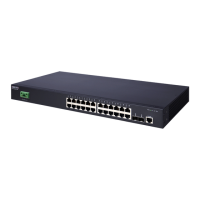Chapter 9
| General Security Measures
ARP Inspection
– 346 –
◆ If static mode is not enabled, packets are first validated against the specified
ARP ACL. Packets matching a deny rule are dropped. All remaining packets are
validated against the address bindings in the DHCP snooping database.
Example
Console(config)#ip arp inspection filter sales vlan 1
Console(config)#
ip arp inspection
log-buffer logs
This command sets the maximum number of entries saved in a log message, and
the rate at which these messages are sent. Use the no form to restore the default
settings.
Syntax
ip arp inspection log-buffer logs message-number interval seconds
no ip arp inspection log-buffer logs
message-number - The maximum number of entries saved in a log message.
(Range: 0-256, where 0 means no events are saved and no messages sent)
seconds - The interval at which log messages are sent. (Range: 0-86400)
Default Setting
Message Number: 20
Interval: 10 seconds
Command Mode
Global Configuration
Command Usage
◆ ARP Inspection must be enabled with the ip arp inspection command before
this command will be accepted by the switch.
◆ By default, logging is active for ARP Inspection, and cannot be disabled.
◆ When the switch drops a packet, it places an entry in the log buffer. Each entry
contains flow information, such as the receiving VLAN, the port number, the
source and destination IP addresses, and the source and destination MAC
addresses.
◆ If multiple, identical invalid ARP packets are received consecutively on the
same VLAN, then the logging facility will only generate one entry in the log
buffer and one corresponding system message.
◆ The maximum number of entries that can be stored in the log buffer is
determined by the message-number parameter. If the log buffer fills up before a
message is sent, the oldest entry will be replaced with the newest one.

